Written by Zac Kurylyk
I was very impressed when I saw Leatt’s new Multitour 7.5 gear on display at AIMExpo last winter. A few months later, when they asked if I’d like to test some of it, I said yes, because I was curious to see just how good the South African manufacturer’s kit was. And after weeks of testing through late spring and summer, I can say that the Multitour gear is much better than I expected—although, like all ADV gear, you need to match it to riding conditions.
The Basic Details
The Multitour 7.5 jacket and pants follow the usual pattern: An outer shell that’s made to protect you from road rash, with armor inserted into pockets at shoulder, back and elbow. The shell itself is made of a ripstop fabric, with Superfabric reinforcment in the areas that are most likely to be impacted in a crash. The outer shell isn’t waterproof.
Waterproofing instead comes from a HydraDri Max liner, which can be removed for airflow, or worn as a standalone rain shell. Styling is better than most of the removable rain liners that you see out there; no, you don’t look like a suave outdoors model, but it’s not bad at all.
Then, there’s a quilted thermal liner. I almost never wear these, but they’re nice to have if you don’t run a heated vest. They really do help keep cold at bay, but once you get off the bike, they’re bulky and you heat up quickly as you move around.
Speaking of heating up: The jacket does have two mesh panels on the front that can be zipped open to get a breeze flowing through. There is a similar panel in the back, as you can see in the title image, where it’s unzipped fully.
The pants have the same three-layer design as the jacket.

The Armor
The jacket comes with EN1621-2 Level 2 pads in back, shoulder and elbow. Unlike most ADV jackets, the Multitour also comes with chest armor, with EN1621-3 Level 2 pads in the front. The armor used is 3DF energy-absorbing impact foam, built in a sort of honeycombed design that allows it to spring back and resist multiple impacts instead of a one-and-done, cracked-and-broken design. The armor also molds itself to your body better, rather than the more rigid stuff that was common in the past.
Leatt used the same stuff to protect your hips and knees. Hip protectors are fairly common amongst ADV gearmakers, but they certainly aren’t universal, so it’s nice to see them include these in the purchase price—and using good ones, too, not the cut-rate foam that you see sometimes.
Lots of pockets up front, in the configuration you want, including handwarmers. Lots of adjustability on the arms and torso, too.
The rear of the jacket has the usual map pocket and also a pocket where you can store a hydration bladder.
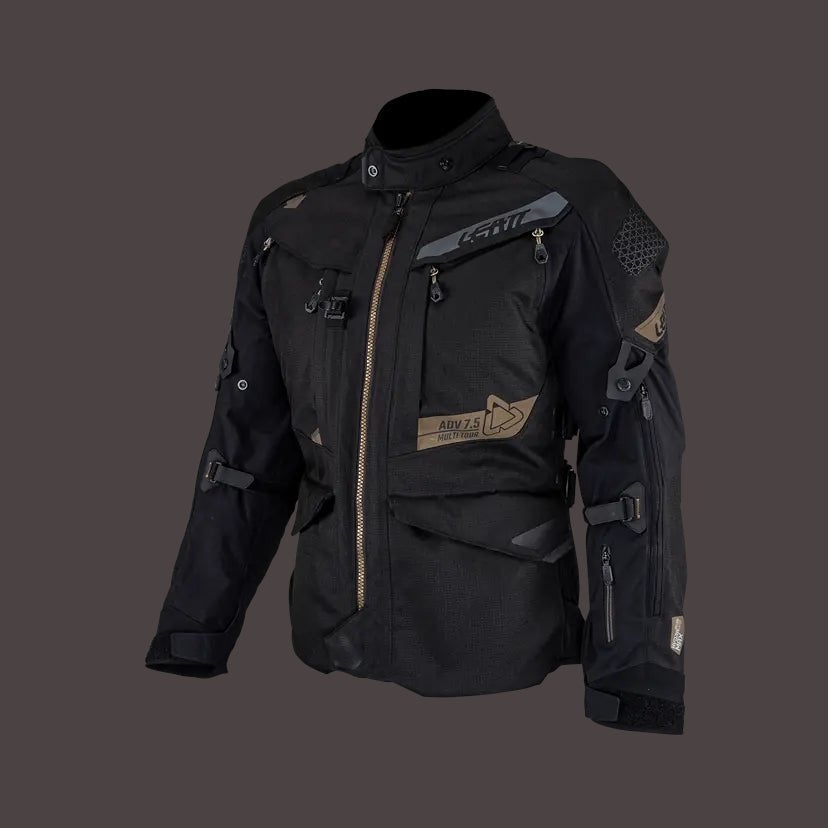
Lots of pockets up front, in the configuration you want, including handwarmers. Lots of adjustability on the arms and torso, too.
Enough Talk—Was It Any Good?
I wore the Multitour 7.5 over thousands of miles through Flugistan this spring and summer, tackling all the weather you’re likely to encounter in the northeast at that time. It was mostly muggy and hot, with the odd soggy, foggy day thrown in. At the end of it all, I can say that I think this is really good stuff. Not perfect gear, but impressive, especially considering it’s really the start of a new line for Leatt.
As soon as I pulled on the jacket and pants, I liked the Multitour kit for two reasons: The jacket and pants fit very well, and the pants were made to stay on.
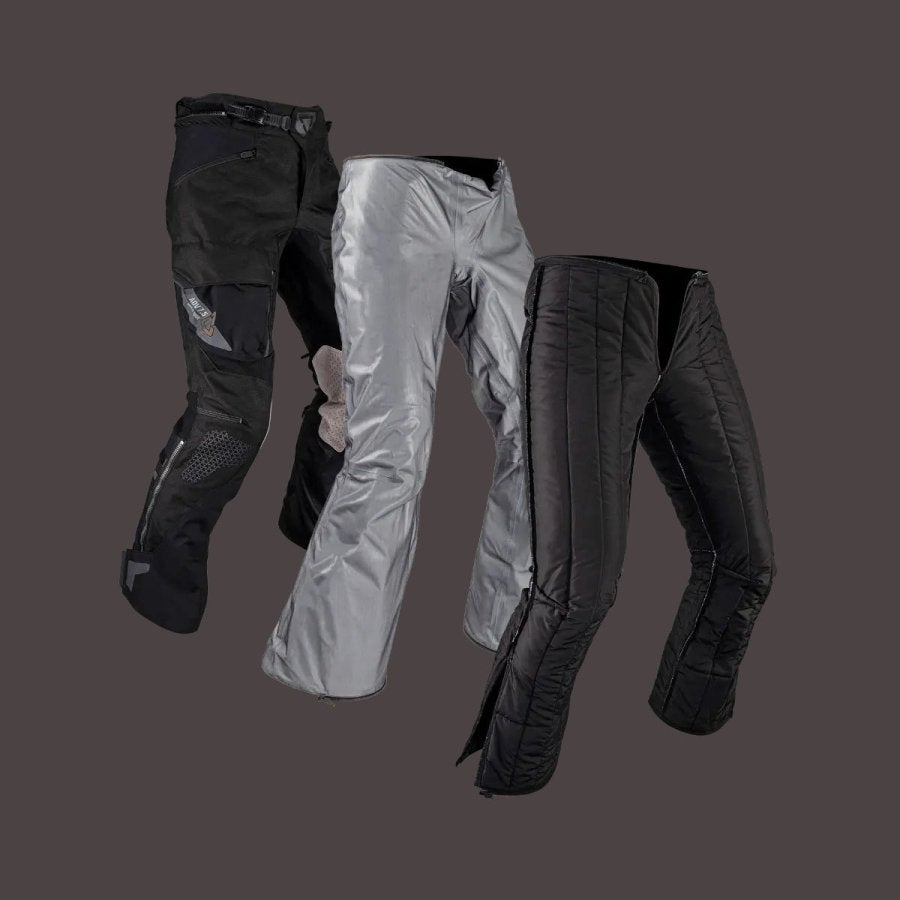
Not shown: Removable suspenders that help keep everything in place, and comfortable.
Too many ADV pants are made with unreliable snaps or other chintzy closure systems; the Multitours come with a buckle system that you do see on some competitors’ gear, but it’s far from universal. The buckle is adjustable, so a steakhouse dinner doesn’t mean a gear blowout. It’s much more secure than the closure you see on a lot of other ADV pants, which have very little holding them closed around your hips in a crash.
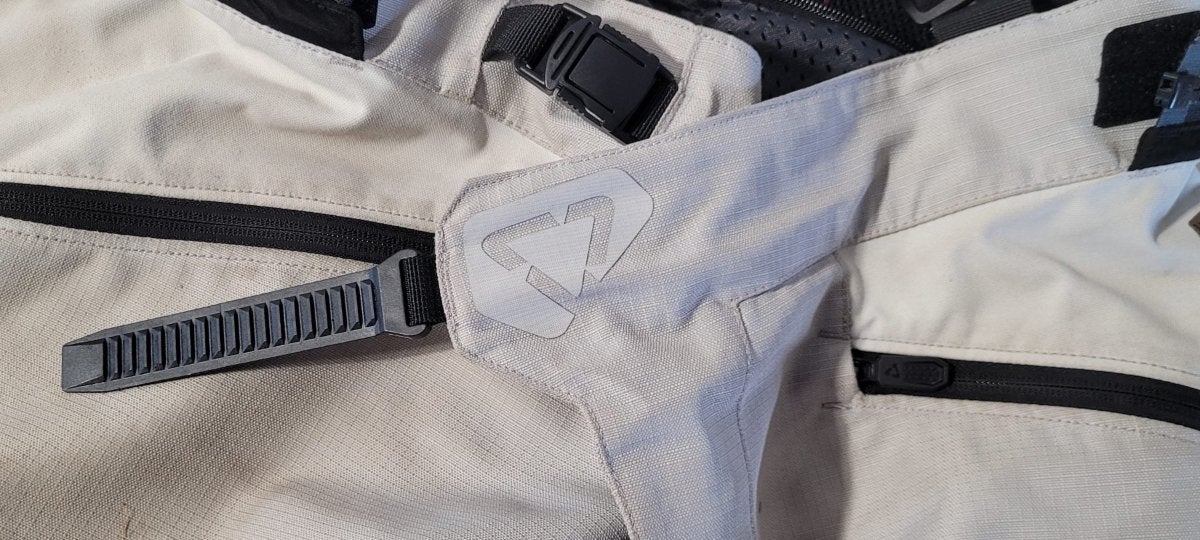
I hope this adjustable, tough pants buckle becomes the industry standard soon.
The Multitour pants also come with removable suspenders. I realize that many riders may not like the Red Green look, but I’ve been married for 16 years, and I’m at the point where I value function a lot more than style now. Suspenders will also help keep your pants up in a crash, and they’re something I want.
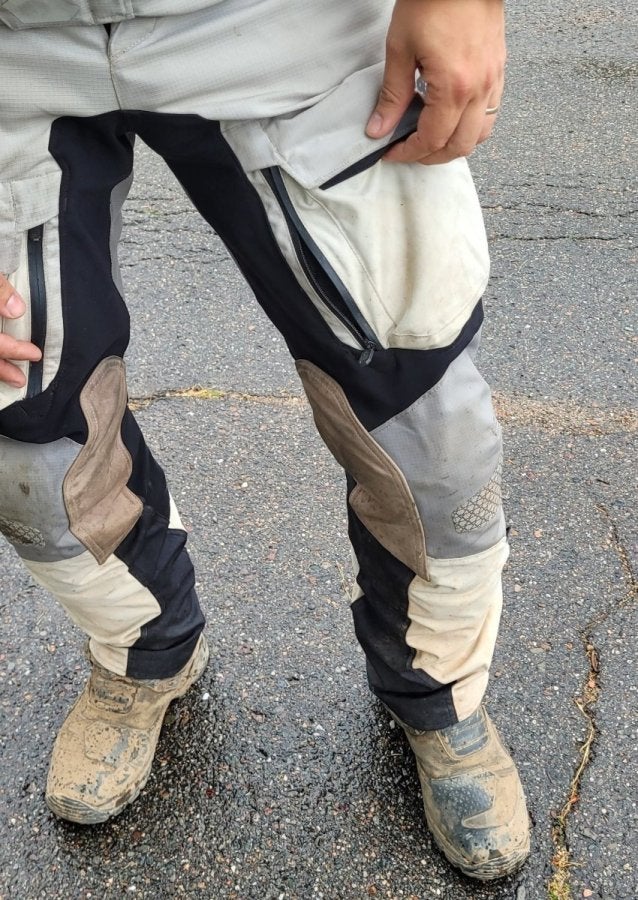
Note the thigh vents; I think these could be redesigned for more airflow. The pockets on the pants were OK, nothing special, but I appreciated the grippy panels on the inside of the legs and the Superfabric on the knees. It would be stupid to have expensive dual sport pants that were write-offs because of a low-speed off, but it can happen if the knees aren’t reinforced well. These pants won’t suffer that fate!
As for the fit: As soon as I put this gear on, it felt broken-in. This is a rare thing with textile gear, or leather moto gear for that matter. Engineering flex and give into the right places, knowing the right areas for a gusset—this is the sort of expertise that a lot of companies don’t get right, even if they’ve been around for a long time. I don’t know who designed this gear for Leatt, but it was super-comfortable right out of the box. There were no tags, no Velcro sticking into me; I felt at home in it immediately.
YMMV of course, but for me, that’s a huge plus in itself. I had no major crashes in this gear, only the sort of slow-speed get-offs that come with dual sport riding, so I can’t say how protective it is in a serious accident. However, if your gear fits well, you’re more likely to be wearing it in the first place, so proper fit can itself be considered a safety feature.
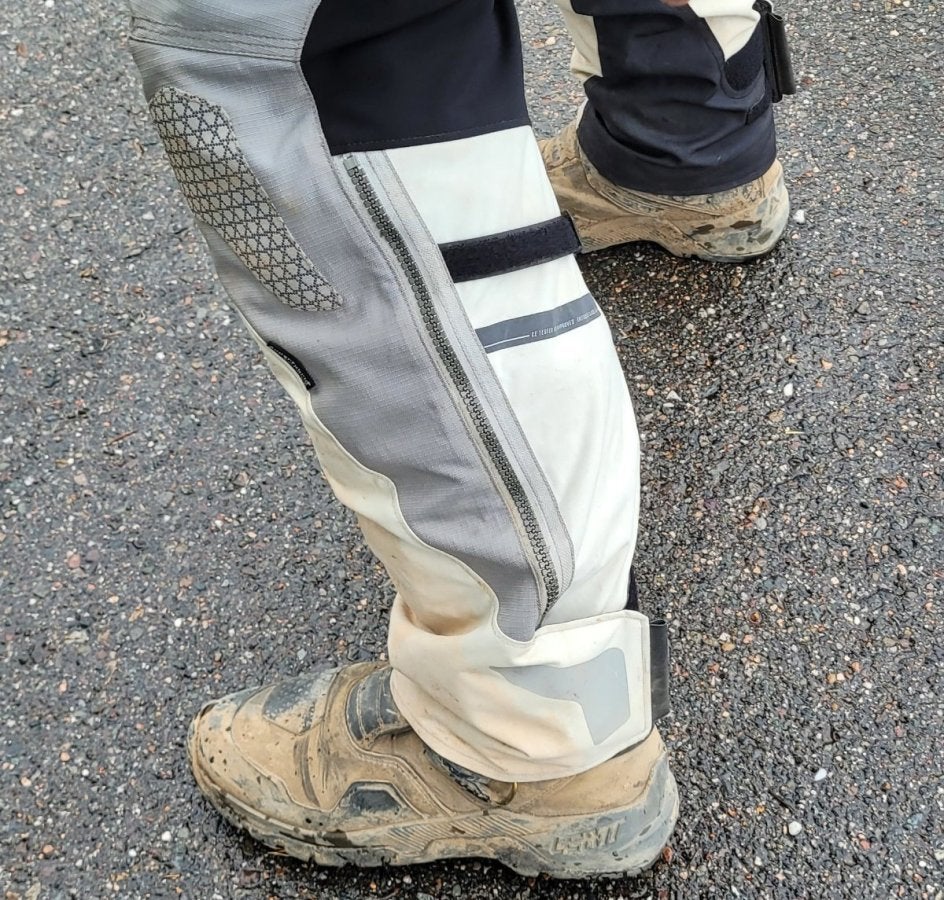
I was a massive fan of the adjustability at the bottom of the pants’ legs. You can get these closed very tightly, which is a huge advantage when you’re riding off-pavement. Or even when you’re on-pavement; I’ve almost come to grief from baggy pants catching a footpeg, when I threw a leg over my DR650. That won’t happen here.
What I Didn’t Like
No gear is perfect, and the internal rain liner design is, in general, something I’ve complained about in the past. I’m not picking on Leatt here—all the OEMs have gear like this, and I realize that it’s an attempt at a compromise, to make equipment that’s comfortable on hot days where you can open the vents. It’s also probably better long-term waterproofing than a integrated membrane, which can’t be replaced when it delaminates.
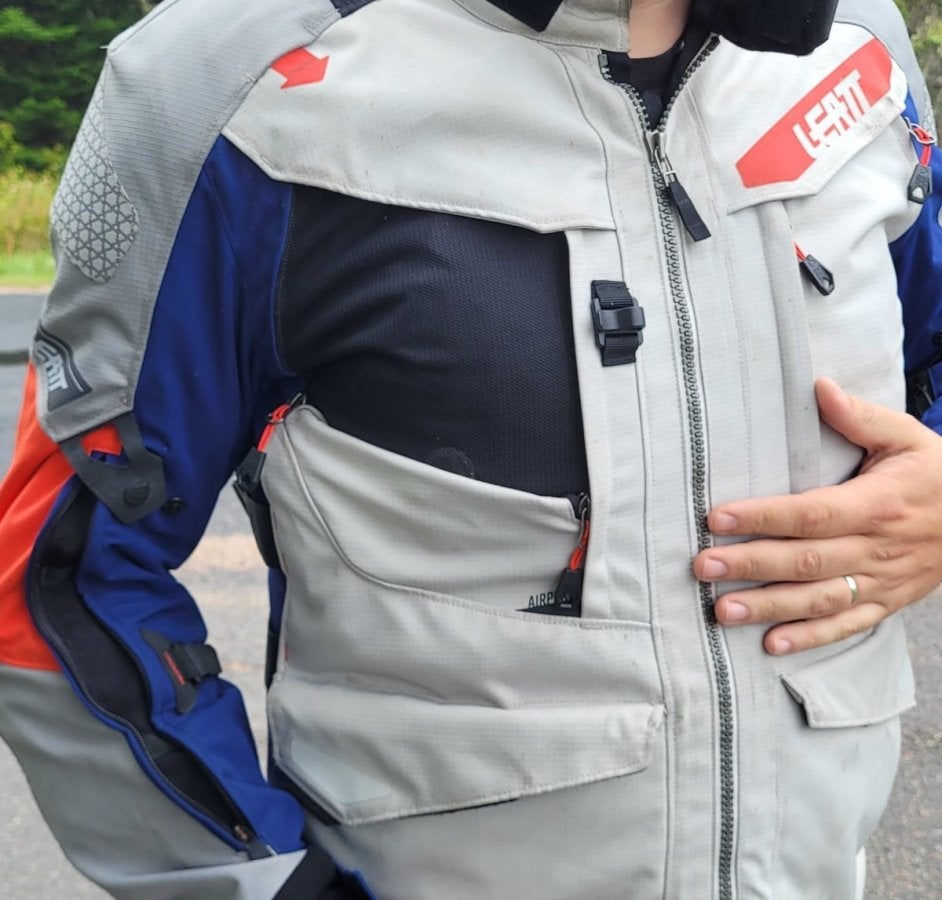
Dual sport features you want: Mesh panels for airflow, a clamp to hold a hydration bladder hose in place, and retention clips for a neck brace. Lots of adjustable straps, for fit. Oh, and decent-sized pockets. Good job on getting these details right, Leatt, although a bit more airflow would have been nice. That’s true of just about every jacket in this class, though.
However, I felt that Leatt could have improved the jacket’s airflow—it was good, but it could have been better. The chest pads somewhat restrict the airflow up front on the jacket, and I felt the pants could have flowed more air too.
Note that Leatt does have the Flowtour gear that has much more mesh built-in, if you really wanted that airflow. If you want to wear this gear a lot in the summer, and you’re OK with the trade-off in safety, you could consider that.
The Final Word
Ultimately, it’s very hard to make all-season moto gear that’s comfortable for an 8- or 9-month range of weather changes. I think Leatt nailed most of the aspects of this gear, and the hot-weather performance is as good as any other jacket in this style. You can find moto gear cheaper than the Multitour 7.5 jacket (about $650) and pants (about $450), but as far as I’m concerned, the features and fit are better than stuff than costs a lot more. I’m impressed with Leatt’s foray into high-end ADV gear, and am eager to see what they come up with next.
I was very impressed when I saw Leatt’s new Multitour 7.5 gear on display at AIMExpo last winter. A few months later, when they asked if I’d like to test some of it, I said yes, because I was curious to see just how good the South African manufacturer’s kit was. And after weeks of testing through late spring and summer, I can say that the Multitour gear is much better than I expected—although, like all ADV gear, you need to match it to riding conditions.
The Basic Details
The Multitour 7.5 jacket and pants follow the usual pattern: An outer shell that’s made to protect you from road rash, with armor inserted into pockets at shoulder, back and elbow. The shell itself is made of a ripstop fabric, with Superfabric reinforcment in the areas that are most likely to be impacted in a crash. The outer shell isn’t waterproof.
Waterproofing instead comes from a HydraDri Max liner, which can be removed for airflow, or worn as a standalone rain shell. Styling is better than most of the removable rain liners that you see out there; no, you don’t look like a suave outdoors model, but it’s not bad at all.
Then, there’s a quilted thermal liner. I almost never wear these, but they’re nice to have if you don’t run a heated vest. They really do help keep cold at bay, but once you get off the bike, they’re bulky and you heat up quickly as you move around.
Speaking of heating up: The jacket does have two mesh panels on the front that can be zipped open to get a breeze flowing through. There is a similar panel in the back, as you can see in the title image, where it’s unzipped fully.
The pants have the same three-layer design as the jacket.

The Armor
The jacket comes with EN1621-2 Level 2 pads in back, shoulder and elbow. Unlike most ADV jackets, the Multitour also comes with chest armor, with EN1621-3 Level 2 pads in the front. The armor used is 3DF energy-absorbing impact foam, built in a sort of honeycombed design that allows it to spring back and resist multiple impacts instead of a one-and-done, cracked-and-broken design. The armor also molds itself to your body better, rather than the more rigid stuff that was common in the past.
Leatt used the same stuff to protect your hips and knees. Hip protectors are fairly common amongst ADV gearmakers, but they certainly aren’t universal, so it’s nice to see them include these in the purchase price—and using good ones, too, not the cut-rate foam that you see sometimes.
Lots of pockets up front, in the configuration you want, including handwarmers. Lots of adjustability on the arms and torso, too.
The rear of the jacket has the usual map pocket and also a pocket where you can store a hydration bladder.

Lots of pockets up front, in the configuration you want, including handwarmers. Lots of adjustability on the arms and torso, too.
Enough Talk—Was It Any Good?
I wore the Multitour 7.5 over thousands of miles through Flugistan this spring and summer, tackling all the weather you’re likely to encounter in the northeast at that time. It was mostly muggy and hot, with the odd soggy, foggy day thrown in. At the end of it all, I can say that I think this is really good stuff. Not perfect gear, but impressive, especially considering it’s really the start of a new line for Leatt.
As soon as I pulled on the jacket and pants, I liked the Multitour kit for two reasons: The jacket and pants fit very well, and the pants were made to stay on.

Not shown: Removable suspenders that help keep everything in place, and comfortable.
Too many ADV pants are made with unreliable snaps or other chintzy closure systems; the Multitours come with a buckle system that you do see on some competitors’ gear, but it’s far from universal. The buckle is adjustable, so a steakhouse dinner doesn’t mean a gear blowout. It’s much more secure than the closure you see on a lot of other ADV pants, which have very little holding them closed around your hips in a crash.

I hope this adjustable, tough pants buckle becomes the industry standard soon.
The Multitour pants also come with removable suspenders. I realize that many riders may not like the Red Green look, but I’ve been married for 16 years, and I’m at the point where I value function a lot more than style now. Suspenders will also help keep your pants up in a crash, and they’re something I want.

Note the thigh vents; I think these could be redesigned for more airflow. The pockets on the pants were OK, nothing special, but I appreciated the grippy panels on the inside of the legs and the Superfabric on the knees. It would be stupid to have expensive dual sport pants that were write-offs because of a low-speed off, but it can happen if the knees aren’t reinforced well. These pants won’t suffer that fate!
As for the fit: As soon as I put this gear on, it felt broken-in. This is a rare thing with textile gear, or leather moto gear for that matter. Engineering flex and give into the right places, knowing the right areas for a gusset—this is the sort of expertise that a lot of companies don’t get right, even if they’ve been around for a long time. I don’t know who designed this gear for Leatt, but it was super-comfortable right out of the box. There were no tags, no Velcro sticking into me; I felt at home in it immediately.
YMMV of course, but for me, that’s a huge plus in itself. I had no major crashes in this gear, only the sort of slow-speed get-offs that come with dual sport riding, so I can’t say how protective it is in a serious accident. However, if your gear fits well, you’re more likely to be wearing it in the first place, so proper fit can itself be considered a safety feature.

I was a massive fan of the adjustability at the bottom of the pants’ legs. You can get these closed very tightly, which is a huge advantage when you’re riding off-pavement. Or even when you’re on-pavement; I’ve almost come to grief from baggy pants catching a footpeg, when I threw a leg over my DR650. That won’t happen here.
What I Didn’t Like
No gear is perfect, and the internal rain liner design is, in general, something I’ve complained about in the past. I’m not picking on Leatt here—all the OEMs have gear like this, and I realize that it’s an attempt at a compromise, to make equipment that’s comfortable on hot days where you can open the vents. It’s also probably better long-term waterproofing than a integrated membrane, which can’t be replaced when it delaminates.

Dual sport features you want: Mesh panels for airflow, a clamp to hold a hydration bladder hose in place, and retention clips for a neck brace. Lots of adjustable straps, for fit. Oh, and decent-sized pockets. Good job on getting these details right, Leatt, although a bit more airflow would have been nice. That’s true of just about every jacket in this class, though.
However, I felt that Leatt could have improved the jacket’s airflow—it was good, but it could have been better. The chest pads somewhat restrict the airflow up front on the jacket, and I felt the pants could have flowed more air too.
Note that Leatt does have the Flowtour gear that has much more mesh built-in, if you really wanted that airflow. If you want to wear this gear a lot in the summer, and you’re OK with the trade-off in safety, you could consider that.
The Final Word
Ultimately, it’s very hard to make all-season moto gear that’s comfortable for an 8- or 9-month range of weather changes. I think Leatt nailed most of the aspects of this gear, and the hot-weather performance is as good as any other jacket in this style. You can find moto gear cheaper than the Multitour 7.5 jacket (about $650) and pants (about $450), but as far as I’m concerned, the features and fit are better than stuff than costs a lot more. I’m impressed with Leatt’s foray into high-end ADV gear, and am eager to see what they come up with next.




